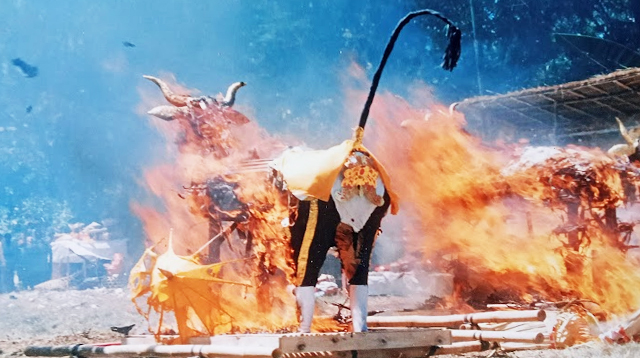BEHIND the billowing smoke and the roar of gamelan music, there is a sacred tradition that connects the human world with the afterlife. Ox sarcophagus, a majestic and sacred figure in the Ngaben ceremony of Hindus in Bali, is not only a symbol of honor, but also a spiritual vehicle that leads the spirit to eternal freedom.
In every detail of the beautiful carving of the ox, there is a deep meaning about life, death, and the journey to moksha. Discover more about the beauty of the philosophy and ritual that combines art, spirituality, and Balinese tradition in this article.
What is an Ox Sarcophagus?
Ox sarcophagus in the Ngaben ceremony is one of the important components used in the cremation ritual of Hindus in Bali. Ngaben is a procession of burning a corpse or symbolic corpse that symbolizes the release of the spirit from the physical body in order to achieve moksha, namely freedom from the cycle of rebirth (samsara).
The ox used in this ceremony is not a living ox, but a statue or replica of an ox that functions as a container (sarcophagus) to place the body before being burned.
Usually, it is shaped like a bull or ox, which is beautifully decorated and carved. Each ox used in the Ngaben procession usually has deep symbolism and is closely related to the social status and origin of the family that is carrying out the ceremony.
Materials for Making the Ox
Ox sarcophagi are usually made of wood and bamboo which are decorated and covered with cloth and then decorated with carved ornaments from matte paper or metallic beautifully
In addition, oxen are often decorated with gold leaf, brightly colored fabrics, and various other decorations to show the splendor and respect for the deceased. Inside, the body will be placed before finally being paraded to the crematorium and burned.
The process of making this ox or sarcophagus is not arbitrary. Local artists and craftsmen in Bali create the ox statue with skill and attention to detail, ensuring that each part has an artistic beauty that reflects high respect for the deceased.
In addition to being shaped like an ox, there are also sarcophagi in other shapes such as large fish with elephant heads or known as Gajah Mina and others.
Function of the Ox Sarcophagus
The main function of the ox sarcophagus in Ngaben is as a symbolic vehicle for the spirit of the deceased to travel to the afterlife. This ox is considered a vehicle for the spirit to be escorted to moksha. The body is placed in the ox, and after a series of prayers and ceremonies are performed, the ox is then burned together with the body, signifying the release of the spirit from its earthly body.
In addition, the ox in the Ngaben ceremony also functions as a medium of respect from the bereaved family to the ancestors or the deceased. The majestic and beautiful shape of the ox reflects the values of honor and great love.
Symbolic and Philosophical Meaning
The ox in Ngaben has a deep symbolic meaning in Hinduism. The ox or bull is considered a sacred animal, especially in the Hindu tradition. In Bali, the ox symbolizes strength, sincerity, and purity. This is in accordance with Hindu teachings which consider the ox as a symbol of Lord Shiva, the god of destruction and re-creation.
The symbolism of the ox in Ngaben also reflects the family’s desire that the spirit of the deceased can achieve eternal happiness and not be reborn into the world. The burning of the ox and the corpse inside is expected to break the spirit’s bond with the material world, speed up the spirit’s journey towards moksha, and free it from the cycle of birth and death.
Philosophically, the Ngaben procession and the use of the ox as a sarcophagus also reflect the belief in the impermanence of the world. Cremation is a symbol that all life in this world is temporary, and death is just another stage in the cycle of life. The ox as the final vehicle shows that the spirit that has achieved liberation is no longer bound to worldly life, and can now move freely towards a higher realm.
Conclusion
The ox or sarcophagus in the Ngaben ceremony of Hindus in Bali is not just a decoration or physical element of the cremation procession. It is a sacred symbol that symbolizes the spirit’s journey towards spiritual freedom, respect for the deceased, and a reminder of the temporary nature of worldly life.
Made with full beauty and meaning, the ox is an inseparable part of the Ngaben procession, reflecting the deep cultural and spiritual values of Balinese society.










